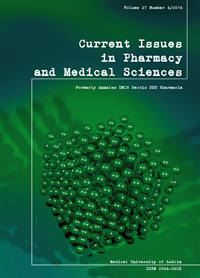Prevalence of Polyomaviruses in Polish patients
DOI:
https://doi.org/10.1515/cipms-2015-0027Keywords:
respiratory tract, co-infection, Polyomaviruses KI and WUAbstract
The aim of our study was to investigate the prevalence of new polyomaviruses KIPyV and WUPyV in the Polish population in the Lublin region. In it, we demonstrated that the prevalence of this viruses is low - 1.1% WU and 3.4% KI. The viruses are most commonly detected in materials from the respiratory tract, both in children and the elderly. Polyomaviruses KI and WU in co-infection, often occur with other respiratory viruses (influenza, enterovirus).
References
1. Babakir-Mina M. et al.: The human polyomaviruses KI and WU: virological background and clinical implications. APMIS 121, 746, 2013.
2. Bialasiewicz S. et al. A newly reported human polyomavirus, KI virus, is present in the respiratory tract of the Australian population. J. Clin. Virol. 40, 15, 2007.
3. Bialasiewicz S. et al.: Development and evaluation of real-time PCR assays for the detection of the newly identified KI and WU polyomaviruses. J. Clin. Virol. 40, 9, 2007.
4. Dalianis T., Hirsch H.: Human polyomaviruses in disease and cancer. Virology 437, 63, 2013.
5. Gaynor A.M., Nissen M.D.: Identification of a novel polyomavirus from patients with acute respiratory tract infections. PLoSPathog. 3, 595, 2007.
6. He Han T. et al: WU Polyomavirus in children with acute lower respiratory tract infections., South Korea. Emerging Infectiuos Diseases 13, 1766, 2007.
7. Kiasari B.A. et. al.: Age-related pattern of KI and WU polyomavirus infection. J.Clin. Virol. 43, 123, 2008.
8. Li X. et al.: WUPyV in children with acute respiratory tract infections. China. Emerg. Infect. Dis. 16, 735, 2010.
9. Lin F. et. al: WU polyomavirus in children with acute lower respiratory tract infections. China J. Clin. Virol. 42, 94, 2008.
10. Mourez T. et al.: Polyomaviruses KI and WU in immunocompromisedpatients with respiratory disease. Emerging Infect. Dis. 15, 107, 2009.
11. Ngyyen N.L., Le B.M., Wang D.: Serologic evidence of frequent human infection with WU and KI polyomaviruses. Emerg., Infect. Dis. 2009, 15.
12. Rao S. et al.: WU and KI polyomavirus infections in pediatric hematology/oncology patients with acute respiratory tract illness. J. Clinical Virology 52, 28, 2011.
13. Robaina T.F. et al.: Shedding of polyomavirus in the saliva of immunocompetent individuals. J. Clin. Virol. 84, 144, 2013.
14. Świątek Ł., Polz-Dacewicz M.: Polyomaviruses as etiological agents of human diseases – a review. Viral infection and control. The role of viral infection in public health. UM, Pol. Tow. Wirusologiczne, Lublin 2010.
15. Van der Zalm M.M. et al.: Prevalence and pathogenicity of WU and KI polyomaviruses in children, the Netherlands. Emerg. Infect. Dis. 14, 1788, 2008.
16. Venter M., Visser A., Lassauniere R.: Human Polyomaviruses WU and KI in HIV exposed children with acute lower respiratory tract infections in hospitals in South Africa. J. Clin. Virol. 44, 230, 2009
Downloads
Published
Issue
Section
License
Copyright (c) 2015 Authors

This work is licensed under a Creative Commons Attribution-NonCommercial-NoDerivatives 3.0 Unported License.


